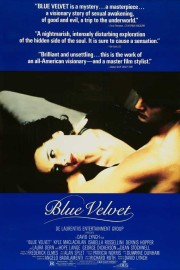Blue Velvet
The only other time I watched David Lynch’s “Blue Velvet” was in 1997, shortly after his “Lost Highway” was released, and baffled me to no end. I was blown away by his 1986 thriller at the time, but have the years been kind to it? I’ve seen all of Lynch’s feature films at this point, and admire him as a singular cinematic artist. Was my initial reaction to “Blue Velvet” correct? Does it hold up when you consider “Twin Peaks,” “Eraserhead,” “Mulholland Dr.” or “Inland Empire,” or has it lost something over the years? A second viewing after experiencing more of Lynch helped “Lost Highway”- what impact would it have on “Blue Velvet?”
The most famous review of the film belongs, arguably, to Roger Ebert, who was sharply against Lynch’s movie, although he admitted that the violent and sexual passages of the film were raw and powerful. What brought the film down, in his mind, was the brutality displayed against Isabella Rossellini’s lounge singer, Dorothy Vallens, and what he saw as an uncomfortable mix of small town satire and harsh, violent realism. Watching the film with those thoughts in mind, he’s not entirely wrong, but I would disagree with him overall. Yes, the abuse Dorothy endures in the film, which includes her rape at the hands of gangster Frank Booth (Dennis Hopper), is difficult to watch, especially with protagonist Jeffrey Beaumont (Kyle MacLachlan) watching in horror in the closet, but it is designed that way intentionally by the director. I was reminded of watching Gaspar Noe’s equally-polarizing “Irreversible” for the first time watching Lynch’s scene, and it’s a just comparison. Neither filmmaker is presenting the moment as titillating, but as a horrific, violent act. In Lynch’s film, though, the added layer of Jeffrey being a voyeur to the moment makes it all the more disquieting. In the context of the film, it plays as a terrible moment of awakening for Jeffrey to the evil that is just below the surface of his idyllic small-town life, but as viewed during a time where “rape culture” is prevalent, it is a powerful indictment of society that has let down victims of sexual assault by treating it less about violence and power and more about sex and “consent.” Yes, we get hints later than Dorothy is a masochist who enjoys “rough sex,” but Frank has all the control, and all the power, during this scene, and she is just a prop for him. Every person who thinks a woman is just “asking for it” should watch either this scene or the scene in “Irreversible,” and tell us if they feel the same way after.
“Blue Velvet” begins with shots of small-town America, in the town of Lumberton, North Carolina, and already, Lynch’s pervasive oddness takes hold. These images are a facade, a representation of how small-town America is remembered more than how it is, and that facade goes away quickly when we see an older man get strangled by a garden hose while watering the flowers outside. After the man falls to the ground, the hose takes on a phallic image that is made just bizarre when a dog begins drinking from it, but the camera than goes down into the dirt to look at the bugs crawling down in the soil, which is as obvious as symbolism gets for what we’re about to watch. The old man is Jeffrey’s father, and Jeffrey returns home from college to help his father and make sure the family store continues to run smoothly. One day, he is walking home in a field by their house, and he comes across a severed human ear. He then takes the ear to the police, and specifically to Detective Williams (George Dickerson), who asks Jeffrey where he found it, and begins to investigate. The detective’s daughter, Sandy (Laura Dern), was Jeffrey’s high school sweetheart, and they rekindle things when Sandy overhears her father looking into the case at home. From that point, Jeffrey goes down the proverbial rabbit hole that will eventually lead him into Dorothy’s closet, and in danger with the unhinged Frank.
It didn’t surprise me, in reading up on the film on Wikipedia, that there’s a lot of personal details in “Blue Velvet” from Lynch. I knew he was born and raised in a small town (and was an Eagle Scout, no less), and this film has a lot of details of small-town life down cold. He then builds a film noir tale out of those details in a way that can make casual viewers uncomfortable, although by the time he revisited this concept with his cult TV series, “Twin Peaks,” audiences were more accepting of it. In retrospect, “Twin Peaks” feels like a more organic proof of concept than “Blue Velvet” does, but “Blue Velvet” remains a mesmerizing experience. The bold cinematography by Frederick Elmes takes us on a road to Hell through Everytown, USA, while the score by Angelo Badalamenti, combined with unsettling sound design, created an unforgettable sonic journey. The cast is exceptional, with Rossellini and Hopper both delivering indelible performances that go to extremes we’re both enthralled with and repelled by. And Lynch is completely in control of his craft as a director, although I feel like he wasn’t quite able to bring it all together until “Mulholland Dr.” 15 years later. “Blue Velvet” is a haunting experience, but I just don’t know if I would consider it a great experience from David Lynch. I think that was still ahead of him, although he certainly wasn’t far off here.










